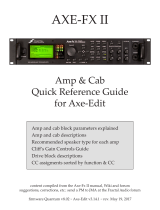Page is loading ...

Zorgverdrive
User manual
Please read carefully this manual, there's some hidden features you must know and important
information to help you protect your ears.
Please feed the pedal with a 9v or a 12v power supply for more headroom.
About the Zorgverdrive sound:
The overdrive range of tones is from clean sound to raging rock sound. It may not fit any metal or
others extreme music addict, but who knows... But for those of you, ladies and gentlemen,
jazz(wo)men, blues(wo)men, funky-soul(wo)men, rock dudes, punk guys, shoogazer, pop nerds,
psychedelic dreamers, I bet there's a sound you want in this box!
As you can see this box as a lot of buttons. I've designed the overdrive for tweakers who like to
have tons of controls and features, thus providing lots of different sounds. Most of the classics
overdrives like the screaming one, the zen one, the rat one etc. use almost the same design with
small variations. This overdrive was made to try to gather all this variations in one box. Thus the
following features are available:
–4 clipping modes: Mosfet, silicon diode, germanium diode, led.
–Symmetrical or asymmetrical clipping.
–Hard or Soft clipping.
–More switch!
I also set the controls to cover a wide range of values:
–The smooth pot remove a lot of treble until you're just left with a boomy sound.
–The bass pot removes all the bass until you get an old radio sound.
–The gain pot goes from x2 to x1000.
–The boost switch multiply the gain by a factor that you can setup with an internal trimpot.
–I used a voltage doubler to get 100% more dynamics.

What are this knobs for?
Vol: Set the output volume of the pedal.
M/D/G/L: This rotating switch sets the clipping mode. See description of the clipping modes
below.
Gain: Sets the gain of the overdrive.
Tre: Passive treble setting. Turn right to remove some treble. When fully on left it removes nothing.
Mid: Active mid setting. Set at noon, it has no effect. Turn left to remove mid frequency around
800Hz. Turn right to add mids.
Bass: Passive bass setting, pre-distortion. Turn left to remove some treble. When fully on right it
removes nothing.
Sym switch: see “about asymmetrical mode” below.
Soft/hard switch: This switch changes the feel of the distortion. In soft, the clipping is a bit more
vintage style. Putting it on hard adds some brightness and a little more dynamic.
About the clipping modes:
Mosfet (M):
Mosfet clipping is fat with good dynamics. The overdrive produced is massive with good bass
response and sweet treble. Use the soft mode to get that zen overdrive type, perfect for low gain
jazz blues settings. It'll also rock with high gain settings or hard mode.
Due to design considerations, in asymmetrical mode, Mosfet clipping is deactivated and the
overdrives act as a clean booster with treble, bass and gain settings.
Silicon diode (D):
It as lower dynamics than the Mosfet, you wanna raise the volume a little bit when switching to
silicon mode. Bass is good and treble are punchy. In soft mode it's more of a screamer. In hard
mode, it is more of rat...
Germanium diode (G):
This is the “dirty” mode of the overdrive. It works poorly with soft symmetrical clipping. But set to
soft asymmetrical, remove smooth, set gain and bass to maximum and get a fuzzy dirty sound.
Push the boost switch for even more grit. Hard modes are... Well I don't know... You tell me...
Led (L):
Maximum dynamics with strong clipping. This is a mode, whether in soft or hard, to use with a
good amount of gain.

About the boost switch.
The boost switch was made to kick the overdrive out when you're soloing. Think of the boost
switch as a button that will add gain and volume, or as a gain/volume preset.
If you unscrew the back of the overdrive and open it, you may see two small blue trimpots. The
one labeled “2k“ sets the gain, the one labeled “10k” sets the volume. These trimpots are set in
factory to give the gain a 2x factor.
With the gain trimpot, if you move it left, you can get less gain, until x0.5 (the switch will lower the
gain!). If you move it right you can get 3x, 4x, and more until x-infinite. You must be very careful
when setting a factor more than 2, if you gain pot is already set to a fair amount, this can send the
pedal into powerfull, harmfull, loud and unstoppable treble feedback.
With the volume trimpot, you’re actually changing the value of the volume when “more” is off. But
all is relative...
About the asymmetrical mode.
With that little switch in the left you can change from symmetrical to asymmetrical clipping mode.
Symmetrical clipping is kind of the standard mode used in classics overdrives. The clipping devices
(the mosfets of eg.) “cuts” the upper and lower parts of the signal to create the distortion. In
asymmetrical clipping, only the upper part of the signal is cut, letting the lower part being
amplified until the opamp saturates. Practically speaking, what you'll hear is a mix between and
overdrived signal and a clean signal, gives more attack, smooths the distortion. Be careful though,
when switching from symmetrical to asymmetrical, the output volume is raised a lot (this is
normal!).
/



